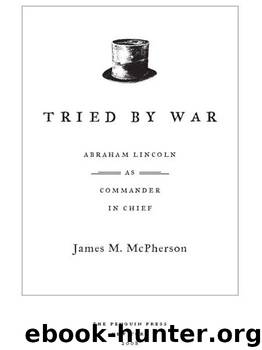Tried by War

Author:James M. McPherson
Language: eng
Format: mobi
Publisher: Penguin
Published: 2008-06-10T16:00:00+00:00
THE TIMING OF Lincoln’s public letters turned out to be fortuitous. Within a few days of their publication Union victories at Gettysburg, Vicksburg, and Port Hudson lifted the pall of Northern gloom and demoralization that had fueled protests against the president’s “despotism.”
When Lincoln visited the Army of the Potomac in the second week of April, he discussed with General Hooker various operational options for a campaign against the Army of Northern Virginia lying across the Rappahannock River. The president wrote a memorandum embodying the main point he wanted Hooker to keep in mind: “Our prime object is the enemies’ army in front of us, and is not with, or about Richmond.”31 They had not decided whether Hooker should cross the river beyond the Confederate left or right flank before Lincoln returned to Washington. On April 11, however, Hooker sent the president a detailed plan of operations. His cavalry would raid Lee’s communications between Fredericksburg and Richmond. At the same time part of the infantry would feint an attack just below Fredericksburg, while the rest marched upriver to cross at fords to come in on the enemy rear. If all went well Lee would either be crushed between the two wings of Union infantry—each almost equal in number to the Confederate infantry—or have to retreat toward the raiding Union cavalry, enabling Hooker to pitch into the enemy rear as the cavalry delayed them in front.32
Before he had left the army on April 11, Lincoln had given Hooker one other piece of advice. Well aware that at Antietam and Fredericksburg at least two corps had scarcely fired a shot, the president said: “In your next fight, put in all your men.”33 If Hooker had done so, events in the next few weeks might have been quite different.
Hooker’s operation began flawlessly. Union cavalry tore up Confederate railroads, but the damage was limited and soon repaired. The flanking infantry successfully crossed the Rappahannock and was advancing on the Confederate rear at Fredericksburg by May 1. But Lee detached Jackson’s corps to block the advance, and Hooker inexplicably pulled back to a defensive position near the crossroads mansion and outbuildings called Chancellorsville. From then on he lost the initiative to Lee, who daringly sent Jackson on a flank march that crushed the Union right on May 2, drove into the center on May 3, and forced the left back across the river on May 4. Hooker gave up and recrossed the whole army to the north bank of the Rappahannock during a driving rainstorm on May 6. Although the Battle of Chancellorsville cost Lee Stonewall Jackson from a friendly fire wound that proved fatal, it was nevertheless a decisive Confederate victory—and a defeat not so much of the Army of the Potomac as of Hooker, who lost control of the battle. And contrary to Lincoln’s advice, he had not put in all of his men. Two of his seven corps and part of another stood virtually idle during the fighting.34
Lincoln spent many anxious hours in
Download
This site does not store any files on its server. We only index and link to content provided by other sites. Please contact the content providers to delete copyright contents if any and email us, we'll remove relevant links or contents immediately.
| African Americans | Civil War |
| Colonial Period | Immigrants |
| Revolution & Founding | State & Local |
Cat's cradle by Kurt Vonnegut(13856)
Pimp by Iceberg Slim(12923)
Underground: A Human History of the Worlds Beneath Our Feet by Will Hunt(11251)
4 3 2 1: A Novel by Paul Auster(11034)
The Radium Girls by Kate Moore(10901)
American History Stories, Volume III (Yesterday's Classics) by Pratt Mara L(4821)
Perfect Rhythm by Jae(4616)
Wiseguy by Nicholas Pileggi(4581)
The Fire Next Time by James Baldwin(4336)
Paper Towns by Green John(4163)
A Higher Loyalty: Truth, Lies, and Leadership by James Comey(4024)
Pale Blue Dot by Carl Sagan(3996)
The Mayflower and the Pilgrims' New World by Nathaniel Philbrick(3905)
The Doomsday Machine by Daniel Ellsberg(3725)
Too Much and Not the Mood by Durga Chew-Bose(3689)
Killers of the Flower Moon: The Osage Murders and the Birth of the FBI by David Grann(3604)
The Borden Murders by Sarah Miller(3581)
The Sympathizer by Viet Thanh Nguyen(3466)
Sticky Fingers by Joe Hagan(3449)
